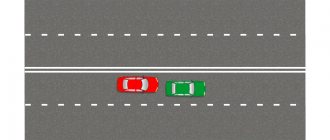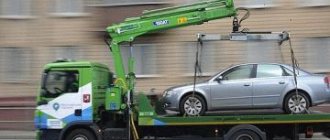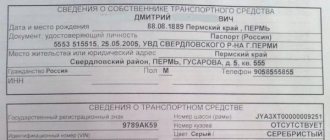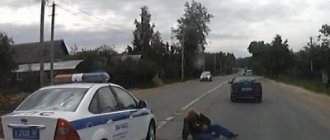What is written about driving in the left lane in the traffic rules?
Answers to all questions about driving in the left lane are contained in clauses 9.4 and 9.5 of the traffic rules. For the most part, the bans apply to suburban routes:
- Outside populated areas, you cannot drive in the left lane, except when turning left or ahead. The same applies to other roads on which driving at speeds over 80 km/h is permitted if they are marked with signs 5.1 (motorway) or 5.3 (road for cars, motorcycles and buses).
- In populated areas you can drive in any lane, with some exceptions. For example, if the maximum speed of a vehicle does not exceed 40 km/h, the driver can only move on the far right. The exception is turns, U-turns, and avoidance of obstacles: in this case, driving to the left is allowed.
- If there are three or more lanes on the road. Here, location does not matter: you can occupy the far left lane only if the other two are occupied by other cars and there is heavy traffic. You are also allowed to exit only to turn left or make a U-turn.
Vehicles with a permissible maximum weight of 2.5 tons may enter the leftmost lane of three or more lanes only to make a U-turn or turn left.
Let's look at a few examples of how this should look in practice:
No. 1. Driving through a populated area. The driver is driving on a two-lane road, taking the extreme left position. There is no violation here: clause 9.4 of the traffic rules contains no prohibitions. Then the number of lanes changes, and there are already three in the same direction. Here the driver can take the far left lane only if the remaining lanes are occupied during active traffic, or he needs to turn left or turn around.
It is worth considering signs and markings. Even if when driving in a city there are two lanes, but there are signs indicating the direction of travel, you need to be guided by them. For example, you cannot drive straight in the left lane if the sign indicates that on this section of the road you can only turn around or turn left.
No. 2. Driving outside the populated area. The end of a populated area is indicated by sign 5.24.1, but restrictions can also be lifted by sign 3.31. A man is driving a car in the right lane. The car ahead is moving at a lower speed, so the other driver is allowed to get ahead of it. After completing the maneuver, he must return to his lane.
Many drivers have an unspoken rule that will help avoid some unpleasant situations. Despite the fact that driving in the city in the left lane is in most cases allowed according to traffic regulations, experienced car owners consider driving there with a free right lane considered bad manners.
Another issue is when both lanes are occupied and the car on the left is driving just as slowly as the one on the right. In fact, it turns out that the entire road is occupied, and those who are driving faster than them from behind will not be able to pass, or they will have to drive into oncoming traffic in violation of traffic rules. According to the rules, both drivers in front are right, but in order to avoid traffic conflicts, it is better not to do this.
Is it illegal to occupy the leftmost lane?
Paragraph 9.4 of the traffic rules states the obligation of drivers to keep to the right edge of the roadway, and also prohibits driving in the extreme left lane if the right lanes are free. This rule applies both outside the boundaries of populated areas and in populated areas with permitted traffic faster than 80 km/h. At the same time, the driver has the right to change lanes to the left closer to the middle of the road to perform maneuvers: 3 “O” (advance, detour , overtaking), turning left or making a U-turn.
The requirement “not to occupy the far left lane if you can go on the right” is due to the stimulation of traffic intensity.
Despite the legal and factual validity of the requirements of the Rule, in reality such incidents often occur. Outside the city on the highway, drivers first occupy the far left lane, and then do not change back to the right lane when it becomes vacant. Such behavior serves as an example of violation of traffic rules.
When is it legal to drive in the left lane?
There are several situations when you can drive into the left lane without fear of a fine:
- if there is another car ahead and you need to overtake it;
- if there is an obstacle on the right in the form of an accident, road work, etc.;
- if the driver wants to turn around or turn left;
- if the right side of the road is broken and driving on it is dangerous.
If we are talking about an area outside the city or about driving on a three-lane road in the city, after completing any of the above maneuvers, you need to return to your lane. The left side cannot be occupied, even if it is empty and there are no other vehicles behind that could be interfered with by the car.
The left lane and its inhabitants
The classification of the inhabitants of the left lane is quite extensive. The main types are listed below.
Summer resident, aka Pensioner, aka Grandfather.
On the left he feels good and calm...
On the left he feels good and calm...
Exists in its own Universe. As a rule, he does not understand in which lane he is moving and why those around him are dissatisfied. He does not try to re-educate anyone, but simply moves in a mode that is convenient for him. He doesn’t react to blinking or buzzing from behind - usually he simply doesn’t notice them.
Principled pedant
What is the fine for driving in the left lane?
If the driver violates clause 9.4 or clause 9.5 of the traffic rules, he may be held accountable under Part 1 of Art. 12.15 of the Code of Administrative Offenses for violating the rules for placing a car on the road. The fine here is 1,500 rubles.
Only a traffic police inspector can record a violation. Cameras recording non-compliance with clause 9.4 or clause 9.5 of the traffic rules have not yet been installed anywhere. A protocol is drawn up on site, which will immediately indicate the details for payment.
If you pay the fine within 20 days, you can take advantage of a discount of 50% of the amount. In the end, only 750 rubles are transferred instead of 1,500 rubles.
Dear reader! Didn't receive an answer to your question? Our expert lawyers work for you. It's absolutely free!
- Moscow ext 152
- St. Petersburg ext 152
- All regions ext 132 (Toll free)
Is there a penalty for driving in the left lane?
Part 1 of Article 12.15 of the Code of Administrative Offenses provides for a fine for driving on the left when the right is free, if this occurs outside the boundaries of a populated area. It is 1500 rubles . This type of fine is charged only to traffic police officers: photo and video recording devices are not yet able to detect and recognize this violation.
Code of Administrative Offenses of the Russian Federation Article 12.15. Violation of the rules for positioning a vehicle on the roadway, passing oncoming traffic or overtaking. Driving in violation of the Traffic Rules into a lane intended for oncoming traffic, when going around an obstacle, or onto tram tracks in the opposite direction when going around an obstacle - entails the imposition of an administrative fine in the amount of one thousand up to one thousand five hundred rubles.
Is it possible to drive in the left lane within the city?
As mentioned earlier, clause 9.4 of the traffic rules applies only to suburban sections of roads. In the city, you can drive in any lane, the main thing is to follow the instructions of the signs and markings.
However, initially the left lane is intended for turns, driving left and overtaking. If you drive it straight, there will be no fine for it. An exception is certain types of vehicles that are prohibited from driving on the left unless absolutely necessary:
- heavy trucks;
- towed and towing vehicles;
- vehicles that technically cannot accelerate to a speed of more than 40 km/h;
- faulty cars whose drivers drive with their emergency lights on.
The above categories of vehicles can drive on the road on the left only if their drivers intend to turn left or make a U-turn.
What to do with them?
Of course, a ram in the left lane is not good. In any case, it interferes with whoever is going faster, and this is already a conflict. Of which we already have plenty. Moreover, as a result, the road capacity decreases. And as a result of changing lanes and jumping from one lane to another, another accident may well occur - here we are already in the lead.
But, to be honest, I personally am more irritated by kind people who push into your rear bumper. It usually doesn’t depend on your speed: for every Mercedes there is always a Ferrari... And, in my opinion, there is only one recipe for behavior: let this kind man through! By God, this will only make things better for everyone.
However, I personally adhere to a different strategy. It’s simple: under no circumstances do I try not to get into the left lane! When I was young, in my father’s Zhiguli, I loved to climb up there, demonstrating to the world my ability to press the right pedal, but today I don’t feel such desires. Although the car has since become four times more powerful. I just decided: this lane is only for overtaking.
And to move the rams from the billboard in space, of course...
Who always occupies the left lane and what to do with them?
What should you do if you were driving in the left lane and stopped by a traffic police officer?
Despite the provided liability, it is extremely problematic to be held accountable for driving in the left lane on a section of the road where it is prohibited unless necessary. Inspectors will have to prove that the driver violated traffic rules. He, in turn, can explain driving on the left as follows:
- the right lane was occupied by another car traveling at a lower speed, and it was necessary to get ahead of it;
- There was an obstacle in the right lane that we had to go around: a hole, a pothole, an accident.
Most often, drivers explain driving in the left lane by looking for a left turn. Inspectors have no right to punish for this. If the protocol is nevertheless drawn up, you need to make a note of disagreement on it and indicate the reasons. After this, the protocol can be challenged through the court or the head of the traffic police.
What's the main problem?
While driving on European roads, I have often noticed how scrupulously local drivers follow this principle - not to occupy the left lane. Whenever possible, take to the right. If they catch up with someone, they pass him on the left and return to the right lane again (even if they are driving slightly overspeed). As a result, a huge number of rebuilds. But they are all relatively safe for one reason - in Europe it is not customary to overtake on the right. This is a common occurrence here. Therefore, on our roads, vacating the left lane immediately after getting ahead of another car, it is quite possible to meet someone who has made the same maneuver in the right lane or even on the side of the road. So, while teaching our drivers not to occupy the left lane, at the same time we need to promote the ban on driving ahead on the right.
- You will find 11 secrets of experienced drivers (they won’t teach you this in a driving school!) here.
The first traffic rules and fines for non-compliance
In 1756, a special bill on left-hand traffic was introduced in Great Britain. Failure to comply with it, especially on bridges, was subject to a large fine. The left side was also adhered to in numerous colonial possessions of Great Britain - on the island colonies, as well as in Australia, Pakistan and India. The bill, as well as fines under it, were in effect in all territories. Fines were imposed for non-compliance with the rules in pre-revolutionary Russia.
To answer the question of why Russia drives on the right, it’s worth going back three centuries. Although people moved along the right side in our country back in the time of Peter I, it was officially approved by Empress Elizabeth. In 1752, she signed the Decree on right-hand traffic for horse-drawn carriages. Around the same period, the first rules for traveling on roads in our country appeared. People still stick to the right side when driving in Russia today. But in a number of states, the rules by which traffic moved on one side or another changed.
A road sign in Australia reminding people that they drive on the left.










